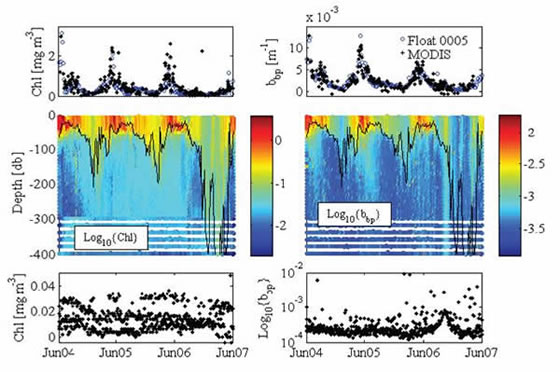Bio-optics
Argo offers global sampling coverage - including high latitudes, which are typically under sampled by ship-based measurements and depth-resolved measurements into the ocean interior, which are not obtained through satellite-derived, remotely sensed ocean colour data. Additionally, the Argo platform provides the potential to carry out sea-truthing (validating and calibrating) of satellite data across a range of oceanic regions under a variety of atmospheric conditions.
Through building a real time vertical profiling time series, the Argo fleet allows continuous sampling of the coupling between biogeochemical and physical processes across a range of timescales (daily, seasonally, inter-annually) and regions.
Chlorophyll-a fluorescence
Chlorophyll-a (Chl-a) is widely used as a proxy for phytoplankton biomass. The latest Argo BIO floats are equipped with fluorometers to measure Chl-a fluorescence. In brief, photons emitted in the blue part of the spectrum are absorbed by Chl-a molecules and are subsequently re-emitted as less energetic photons in the red part of the spectrum.
Backscatter and beam attenuation
Beam backscatter and attenuation at certain wavelengths (555-660 nm) results from the incidence of the beam with particles in the water column. While the effect of particles is dependent on particle size distribution and composition, these effects are found to linearly correlate to particulate organic carbon (POC) in oceanic waters (after applying a salt water correction). Therefore, backscatter is used as a proxy for POC.
Argo bio-optical sensor
Environmental Characterization Optics (ECO) FLbb-AP2 sensor allows chlorophyll fluorescence (at 470 nm excitation, 680 nm emission) and particle backscatter (at 700 nm) to be measured within the same volume of water. Argo floats fitted with this sensor allow exploration and direct observation of episodic events, eddy impacts and seasonal bloom dynamics in remote ocean regions.

Comparison of Argo and satellite derived chlorophyll data
The figure above is taken from Boss et al. (2008). Their study compared Argo float chlorophyll and backscatter data with satellite data. Chlorophyll data is shown in the left hand panels while backscatter data is displayed on the right. The top set of panels show surface chlorophyll concentrations and backscatter derived from the Argo float in question and the MODIS ocean colour satellite against time. The middle row shows a time series of the depth profiles of chloropyhll and backscatter obtained by the Argo float, the bottom panel shows the accompanying depth-integrated values.
Boss et al. (2008) found good agreement between surface concentrations derived from Argo and satellite measurements. However, the Argo depth profiles indicated a large flux of biogenic matter out of the surface mixed layer during an eddy event in late 2006, which there was no indication of from the satellite data that only showed slightly elevated chlorophyll concentrations at the surface.
Limitations
The relationship between chlorophyll fluorescence and concentration is inherently variable as the chlorophyll-fluorescence relationship varies as a function of cell size, accessory pigments, species, nutritional status and light history. For example, the chlorophyll-fluorescence calibration varies greatly between a diatom monoculture versus that of a cyanobacterium culture. The scale factor used in deriving chlorophyll from Argo recorded fluorescence is determined using a monoculture of phytoplankton and thus will carry some imprecision when applied to the real environment where phytoplankton communities will likely be mixed species.